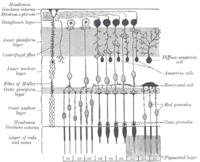
Effects of lighting regimes on performance, pineal melanopsin expression and melatonin content in native laying hens aged from 19 to 34 weeks.
Sign Up to like & getrecommendations! Published in 2021 at "Poultry science"
DOI: 10.1016/j.psj.2021.101567
Abstract: Melanopsin, a key light sensitive pigment, plays an important role in the regulation of bio-rhythm and photo-adaptation in poultry. This study aimed to investigate the effects of different lighting regimes on performance, pineal melanopsin expression… read more here.
Keywords: melanopsin; group; pineal melanopsin; lighting regimes ... See more keywords

Long-term expression of melanopsin and channelrhodopsin causes no gross alterations in the dystrophic dog retina
Sign Up to like & getrecommendations! Published in 2017 at "Gene Therapy"
DOI: 10.1038/gt.2017.63
Abstract: Several preclinical studies have investigated the potential of algal channelrhodopsin and human melanopsin as optogenetic tools for vision restoration. In the present study, we assessed the potentially deleterious effects of long-term expression of these optogenes… read more here.
Keywords: melanopsin; long term; channelrhodopsin; term expression ... See more keywords

Melanopsin, a Canonical Light Receptor, Mediates Thermal Activation of Clock Genes
Sign Up to like & getrecommendations! Published in 2017 at "Scientific Reports"
DOI: 10.1038/s41598-017-13939-3
Abstract: Melanopsin (OPN4) is a photo-pigment found in a small subset of intrinsically photosensitive ganglion cells (ipRGCs) of the mammalian retina. These cells play a role in synchronizing the central circadian pacemaker to the astronomical day… read more here.
Keywords: melanopsin; canonical light; melanopsin canonical; heat ... See more keywords

The Melanopsin-Mediated Pupillary Light Response Is Not Changed in Patients with Newly Diagnosed Idiopathic Intracranial Hypertension
Sign Up to like & getrecommendations! Published in 2018 at "Neuro-Ophthalmology"
DOI: 10.1080/01658107.2017.1344251
Abstract: ABSTRACT Previously, it has been reported that melanopsin-mediated pupillary light response (PLR), measured with pupillometry, is reduced in patients with idiopathic intracranial hypertension (IIH), indicating the clinical utility of the tool in the diagnosis of… read more here.
Keywords: melanopsin; pupillary light; melanopsin mediated; idiopathic intracranial ... See more keywords

Encoding of environmental illumination by primate melanopsin neurons
Sign Up to like & getrecommendations! Published in 2023 at "Science"
DOI: 10.1126/science.ade2024
Abstract: Light regulates physiology, mood, and behavior through signals sent to the brain by intrinsically photosensitive retinal ganglion cells (ipRGCs). How primate ipRGCs sense light is unclear, as they are rare and challenging to target for… read more here.
Keywords: primate; melanopsin; environmental illumination; encoding environmental ... See more keywords

Daylights with high melanopsin stimulation appear reddish in fovea and greenish in periphery
Sign Up to like & getrecommendations! Published in 2023 at "PLOS ONE"
DOI: 10.1371/journal.pone.0285053
Abstract: Melanopsin reportedly contributes to brightness and color appearance in photopic vision in addition to cone photoreceptor cells. However, the relationship between the contribution of melanopsin to color appearance and retinal location is unclear. Herein, we… read more here.
Keywords: melanopsin stimulation; high melanopsin; color appearance; melanopsin ... See more keywords

Melanopsin elevates locomotor activity during the wake state of the diurnal zebrafish
Sign Up to like & getrecommendations! Published in 2022 at "EMBO Reports"
DOI: 10.15252/embr.202051528
Abstract: Mammalian and fish pineals play a key role in adapting behaviour to the ambient light conditions through the release of melatonin. In mice, light inhibits nocturnal locomotor activity via the non‐visual photoreceptor Melanopsin. In contrast… read more here.
Keywords: locomotor activity; diurnal zebrafish; melanopsin; activity ... See more keywords

Melanopsin Cell Dysfunction Is Involved in Sleep Disruption in Parkinson's Disease.
Sign Up to like & getrecommendations! Published in 2020 at "Journal of Parkinson's disease"
DOI: 10.3233/jpd-202178
Abstract: BACKGROUND Melanopsin-expressing intrinsically photosensitive retinal ganglion cells (ipRGCs) signal the environmental light to mediate circadian photoentrainment and sleep-wake cycles. There is high prevalence of circadian and sleep disruption in people with Parkinson's disease; however, the… read more here.
Keywords: parkinson disease; sleep disruption; disease; melanopsin ... See more keywords

Robust visual cortex evoked potentials (VEP) in Gnat1 and Gnat2 knockout mice
Sign Up to like & getrecommendations! Published in 2022 at "Frontiers in Cellular Neuroscience"
DOI: 10.3389/fncel.2022.1090037
Abstract: Intrinsically photosensitive retinal ganglion cells (ipRGCs) express the photopigment melanopsin, imparting to themselves the ability to respond to light in the absence of input from rod or cone photoreceptors. Since their discovery ipRGCs have been… read more here.
Keywords: knockout; melanopsin; rod cone; evoked potentials ... See more keywords

Colour and melanopsin mediated responses in the murine retina
Sign Up to like & getrecommendations! Published in 2023 at "Frontiers in Cellular Neuroscience"
DOI: 10.3389/fncel.2023.1114634
Abstract: Introduction: Intrinsically photosensitive retinal ganglion cells (ipRGCs) integrate melanopsin and rod/cone-mediated inputs to signal to the brain. Whilst originally identified as a cell type specialised for encoding ambient illumination, several lines of evidence indicate a… read more here.
Keywords: cone; cone mediated; retina; mediated responses ... See more keywords

A new method to quantify the human visual threshold from melanopsin sensitive ganglion cells
Sign Up to like & getrecommendations! Published in 2023 at "Frontiers in Cellular Neuroscience"
DOI: 10.3389/fncel.2023.1132230
Abstract: Traditional photoreceptors utilize the chromophore retinal to absorb light coupled with a unique opsin protein to specify receptor spectral sensitivity. Light absorption triggers a cascade of events transducing light energy to neural signals beginning with… read more here.
Keywords: ganglion; melanopsin; ganglion cells; visual threshold ... See more keywords